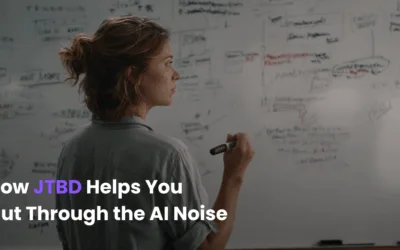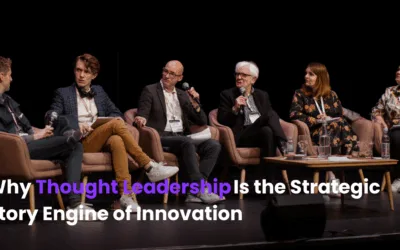AI is getting really good at creative problem-solving – so good, in fact, that it’s starting to take over many jobs. Need a new product idea? AI can generate thousands of concepts in seconds. Struggling with a design? AI will draft ten options before you’ve finished your coffee. Sounds great, right?
Well, maybe. But maybe not.
In late 2024, an interesting MIT study of AI use in materials research found that while AI-assisted researchers discovered 44% more new materials (leading to a 39% increase in patent filings – which is huge), it also automated 57% of idea-generation tasks. That meant scientists spent far less time coming up with their own ideas and much more time just evaluating the suggestions made by the AI engine.
But crucially, 82% of the scientists said they felt less creative and less satisfied with their work as a result.
This is the paradox of AI-powered creativity. It boosts innovation, but it also risks turning humans into mere editors of machine-generated creative outputs. Instead of solving problems from scratch, we’re approving, tweaking, and filtering AI’s outputs.
In this post, we’re exploring whether AI is limiting human ingenuity, or whether it is just forcing us to rethink what creativity actually looks like.
The Editor Problem
AI can generate ideas at an incredible speed, but that doesn’t mean those ideas are good. They are often spectacularly bad. So right now, humans are still needed to filter out the nonsense, refine the promising bits, and make the final call. But in so doing, humans become idea editors rather than the source of great ideas.
And this isn’t just an R&D problem; it’s happening across industries. Marketers are tweaking AI-generated ad copy. Designers are refining AI-created visuals. Writers are fact-checking and rewriting AI-drafted articles. Even in leadership, AI-driven analytics are shaping decisions before executives weigh in.
There’s a genuine risk here. Human creativity and problem solving could atrophy, and we may lose our capacity for discernment. And if we have a whole generation of workers who are never charged with coming up with their own ideas, we may eventually lose expertise in some fields.
There are already some pretty hideous examples of people being unable to problem solve fast enough to avoid disaster when support systems fail. (See, for instance, this awful story.) We can’t afford to lose the capacity to problem solve and to come up with creative solutions – both generally and at speed.
So, how do we keep human creativity alive in an AI-driven world?
Sustaining Human Creativity in an AI-Driven World
From a sheer efficiency perspective it makes sense for AI-assisted creative problem-solving to become part of the way we work. But we can still work to stop human ingenuity from fading into the background.
Humans should be charged with defining problems, questioning assumptions, and making the big creative leaps that AI can’t make (yet).
A major weakness of AI is that it works best within predefined parameters. It doesn’t challenge assumptions, rethink the question, or identify what’s missing. It just generates outputs based on what it already knows. That’s a problem, because defining the problem is often more important than generating solutions.
Identifying problems worth solving, and involving people in the prioritisation and experience of problems, is key to ensuring that AI is better equipped with what it needs to shape solutions. And solutions that reflect human values, cultural context and socio-economic trends are more likely to be accepted and adopted anyway.
Then there is the issue of cross-disciplinary collaboration. AI is trained on historical data, which means it often reinforces existing biases and trends, and because that training data is defined by its discipline-based context, the ideas that AI produces can be limited by that silo orientation. Some of the most innovative breakthroughs come from problems which are explored by people from a diversity of skill sets and disciplines.
Where organisations can foster cross-disciplinary collaboration they will avoid an AI-generated echo chamber of “expected” solutions.
Finally, it’s worth harking back to Daniel Kahneman’s research on “Slow Thinking”. If creative problem solving success is measured purely in speed and efficiency, AI will always win over human creativity. But research suggests that the best ideas often come from slow, iterative processes, where insights emerge over time, through reflection and discussion.
Keeping Creativity Alive
AI is a powerful tool, but it shouldn’t define creativity; it should enhance it. The challenge now is building systems that keep humans in control of creative problem-solving, ensuring that AI is a partner, not the main event.
Because here’s the reality: If we don’t actively work to sustain human ingenuity, we won’t just lose our ability to create. We might even lose our ability to think.
Further reading:
- Brown, T. (2009). Change by Design: How Design Thinking Creates New Alternatives for Business and Society. HarperBusiness.
Kahneman, D. (2011). Thinking, Fast and Slow. Farrar, Straus and Giroux. - Finke, R. A., Ward, T. B., & Smith, S. M. (1992). Creative cognition: Theory, research, and applications. The MIT Press.
- Sio, U. N., & Ormerod, T. C. (2009). Does incubation enhance problem solving? A meta-analytic review. Psychological Bulletin, 135(1), 94–120. https://doi.org/10.1037/a0014212



